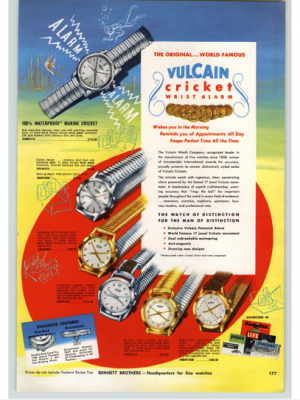Vulcain Cricket

Vulcain Cricket

Vulcain had been working on a wrist watch alarm since 1942 and aimed to solve the problems of previous attempts. Instead of comprising on the alarms length by using only one mainspring, Vulcain fitted a separate spring in the movement that would solely power the alarm and by rotating the crown in different directions, the winding stem would switch between the different barrels instantly.
To increase the volume of the alarm, the hammer would strike a pin connected to a metal membrane that would act as a resonator. This membrane was covered by an outer case with sound holes, similar to that on a cello, that allowed the sound to escape. A pusher at 2 o'clock would allow the user to stop the alarm once they were alerted, rather than letting it run down. The watch was called the Vulcain Cricket as the hammer would strike up to 1300 times in just 25 seconds to create a very distinctive mechanical chirping sound.
Released in 1947, the Cricket became a huge success with Vulcain releasing several variations over the years such as the Golden Voice, a smaller watch made for women with a gold membrane that maintained excellent sound despite a smaller size. The new Caliber 401 released in 1958 added a date and subsidiary seconds but was never as popular as the addition of the date window meant there was no room for a second barrel which decreased the alarm time and increased the cost.
The Presidents Connection

In January 1953 the Chairman of the White House Press Photographer's presented Harry S. Truman a Vulcain Cricket. This marked the beginning of a tradition which continued right up to President Bill Clinton. In 1956 during a press conference the Vulcain Cricket of Dwight D. Eisenhower sounded it's alarm for everyone to hear. This led to a new advertising slogan: "Do as Ike does!"
See The Vulcain Cricket and The President for more information.
The Divers Model
The Nautical Cricket was introduced in 1961 as a true diver's instrument, taking the functionality of the mechanical alarm a step further with the addition of decompression tables built right into the dial. It was designed with the help of diver Hannes Keller who, at the time, held the record for deepest dive (222 meters). The 16 holes in the case back meant the alarm was audible even at these depths. All this to minimize risk to the diver who did not have access to the kinds of diver computers their contemporaries enjoy today. For more information on The Divers Version see Vulcain Cricket Nautical.
